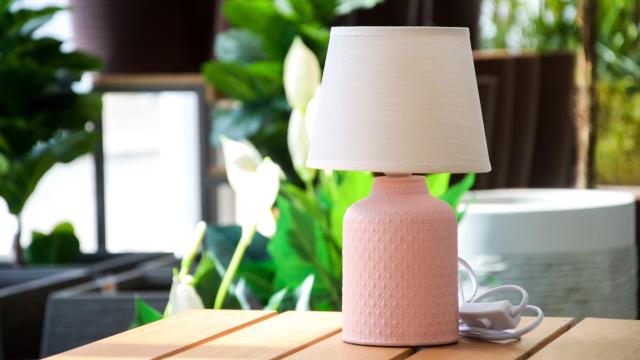Lamps tend to have a longer shelf-life than cushioned pieces of furniture like couches, recliners, and upholstered chairs. They’re much easier to move (and therefore, to give away to family or friends when you no longer need them), don’t start sagging over the years, and as long as the wiring works, are pretty easy to get up and running — even if they’ve been sitting around for a long time.
And while those are all great qualities in a household item, a lamp that was originally purchased when your aunt remodeled her home in 1997 may not work with your current decor. Or, maybe you found a vintage lamp with an interesting base, but awful lampshade (or a lampshade that’s the perfect shape, but the wrong colour, or stained from age).
In situations like those, you may want to consider painting the lampshade. And in an article for The Spruce, Lauren Thomann provides information and tips on how to do just that. Here are some of your lampshade-painting options.
How to prep the lampshade
Before you get started with the paint, first you need to clean the lampshade. Thomann suggests doing this by removing any dust, debris, or lint using an attachment on your vacuum cleaner. If you don’t have a vacuum with attachments, or the lampshade is too delicate to be vacuumed, try using a lint roller, or a soft cloth and a light touch instead.
This step is important, Thomann says, because any leftover dust or debris will end up getting stuck in the paint, and could prevent you from achieving your desired result (and lampshade of your dreams).
Different types of paint and techniques
Now it’s up to you to decide what type of paint to use, based on the amount of time (and patience) you have, as well as the look you want to achieve. Here are a few options:
Watercolor
Of all the types of paint and methods, it’s clear that Thomann is a particularly big fan of using watercolor paints on lampshades. In fact, the bulk of the article is a step-by-step guide to this technique.
In the tutorial, Thomann paints over the design embossed on the lampshade in a variety of colours, and notes that watercolor is ideal for creating an ombre effect. Plus, any watercolor paints you have (or buy) will do: Thomann says that there’s no need to invest in anything costly.
Spray paint
Short on time (and/or patience) and simply want to change the colour of the lampshade? That’s a job for spray paint, Thomann says, noting that the job requires goggles and a respirator, and should be done outdoors.
Pick your colour, and spray paint one coat on the lampshade. When it’s dry, pop it back on the lamp, turn it on, and see if you missed any spots, or the paint is uneven. If you’re happy with the results, then you’re all set. If not, go for a second coat.
Fabric paint
You may also want to consider using fabric paint, which is made of “an acrylic polymer that bonds to cloth and will stand up to some abuse from dusting and heat from a hot light bulb,” Thomann explains. This means that it shouldn’t crack or fade over time.
Another perk of fabric paint is that you can apply it lightly, or via a heavy coat to best suit your decor (unlike watercolor and spray paint, which are less versatile). Not only that, but Thomann says that if you’re planning to use adhesive cloth tape to create a design on the lampshade or mask out an area, fabric paint is the way to go.

Leave a Reply
You must be logged in to post a comment.